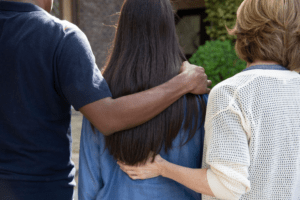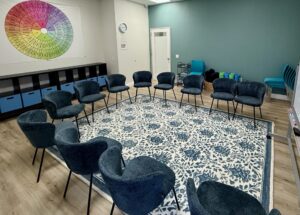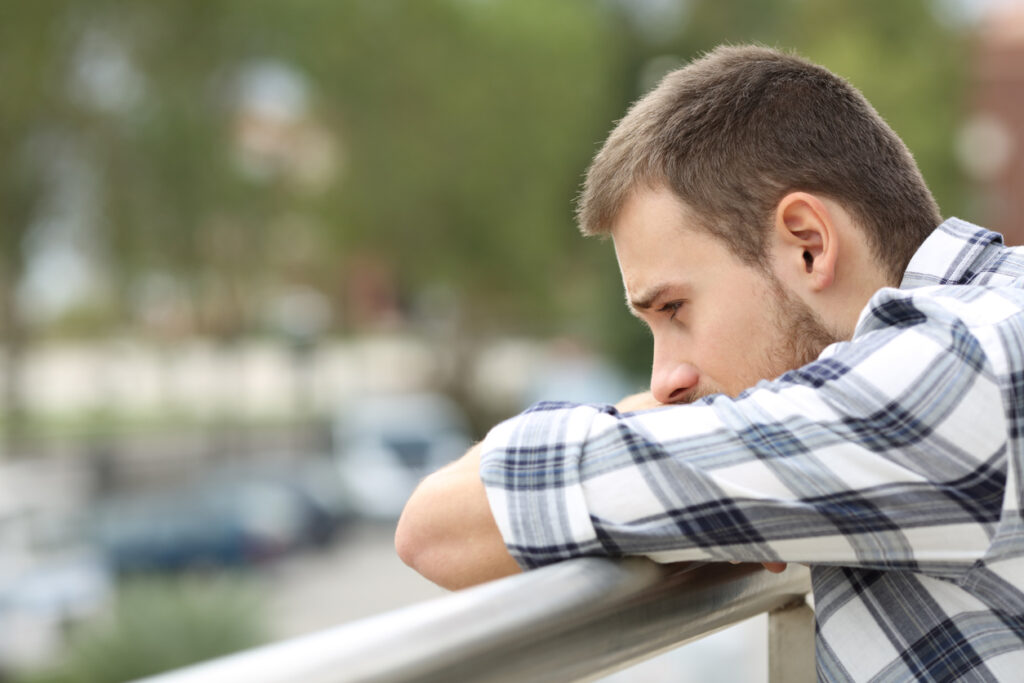Evidence-Based Care for Teens With Anxiety
We all know what it’s like to worry about something.
From the mundane to the consequential, dealing with anxious thoughts is part of being human. During childhood and adolescence, most of us learn to process our worries – i.e. our anxiety – in healthy and productive ways. Over time, we develop the ability to determine which thoughts we should pay attention to and which thoughts we should dismiss. In addition to that, we learn how to channel our worry and anxiety over important things into positive, proactive behavior.
For instance, a school age child may worry about an upcoming test, an important game, or a big recital. With the help of adults, they learn to direct the energy embedded in that worry or anxiety to help them prepare for the test, the game, or the recital.
That’s how anxiety helps. It allows us to preview and prepare for what’s coming.
Adolescents have more on their plate than school age children. That means it’s perfectly natural for them to have more anxiety or worry than their younger peers. However, the process we describe above is the same for adolescents as it is for children. They learn to identify which worrisome thoughts merit their attention and which don’t. Then they learn how to process thoughts about the important things – i.e. grades, family issues, and the like – and let go of the things that are less important.
Their anxiety helps them grow.
But when anxiety interferes with daily life and impairs the ability participate in regular activities, that’s not helpful. There’s no advantage conferred. When anxiety persists and crosses the threshold from helping to hurting, it becomes a mental health issue, which mental health professionals call an anxiety disorder.
Treatment for that type of anxiety is what this article is about.
Anxiety: A Clinical Definition
Before we discuss treatment for anxiety, we need to know exactly what a mental health professional means when the refer to an anxiety disorder. The National Association on Mental Illness (NAMI) indicates that all the various anxiety disorders recognized by the Diagnostic and Statistical Manual of Mental Disorders (DSM-5) have one distinguishing feature in common:
“A persistent, excessive fear or worry in situations that are not objectively or inherently dangerous.”
That definition implies something we didn’t mention above, but hinted at. Worry and anxiety not only help us preview and prepare for what’s coming, but also – at a more fundamental level – help keep us alive. Fear of predators helped our ancestors make smart choices about where to hunt and gather. Worry about weather helped our ancestors make smart choices about where to sleep. Modern survival worries are similar. Anxiety about our jobs and the welfare of our families help us survive in the same way worry about predators and the environment help our ancestors survive.
An anxiety disorder, however, is characterized by thoughts and fears that, when we dig deep, we learn are unrelated to our survival. They’re based in a positive phenomenon, but they can go wrong. When they do, they can cause problems. Millions of people around the world experience these problems. Those millions include for far more adolescents than most of us realize.
Prevalence of Youth and Teen Anxiety: Worldwide and in the U.S.
Experts from the World Health Organization (WHO) estimate that worldwide:
- 3.6% of youth (10-14) have an anxiety disorder
- 4.6% of teens/early adults (15-19) have an anxiety disorder
We have detailed data on the prevalence of anxiety among adolescents in the U.S. The following information is available from the National Institutes of Health (NIH), the Centers for Disease Control (CDC), and the Child Mind Institute.
Here’s what these sources tell us about anxiety among U.S. teens:
- Age 13-18: 31.9% (about 7.5 million)
- Age 13-14: 31.4%
- Ages 15-16: 32.1%
- Age 17-18: 32.3%
- Females 13-18: 38%
- Males 13-18: 26.1%
- With severe impairment, female and male, age 13-18: 8.3%
Now let’s look at one more study, called “Global Prevalence of Depressive and Anxiety Symptoms in Children and Adolescents During COVID-19: A Meta-analysis.” This meta-analysis examined anxiety prevalence rates among youth after a year of the coronavirus pandemic and compared them to pre-pandemic rates. Researchers collected this data between March 8th and 22nd, 2021, and included information from 136 studies with almost 81,000 participants.
Here’s what they found:
- Anxiety before March 2020 (youth 18 and under): 11.6%
- Anxiety during March 2021 (youth 18 under): 20.5%
What we see here is that worldwide, anxiety among youth doubled during the pandemic. While these sets of statistics are not apples-to-apples comparisons, we’ll explain why they help us understand anxiety among teens where we are now, at the beginning of 2022. First, diagnosable anxiety is more prevalent in older teens than in young children and school age kids. That explains the lower WHO rates when compared to rates among U.S. teens age 13-18. Therefore, when we look at those WHO statistics, we can see the dramatic increase in anxiety among youth caused by the pandemic.
The Pandemic Effect
We know that natural disasters, large accidents – think Chernobyl and Fukushima – and events like terrorism and war increase anxiety rates temporarily. But those elevated rates typically decrease within months after the event. The ongoing, start-stop-start nature of the coronavirus pandemic introduces an unknown, since we don’t have reliable data on how an extended period of uncertainty will affect our young children, youth, and teens.
Dr. Sheri Madigan, PhD, interviewed in Forbes magazine about the results of the worldwide meta-analysis, offers this insight:
“We’re continuing to see compounding effects of the pandemic. It’s disjointing for kids because they can’t predict what their environment is going to look like, and we know when their world lacks predictability and controllability, their mental health suffers.”
One thing we do know, however, is that evidence-based treatment for anxiety works.
Evidence Based Treatment for Teens with Anxiety Disorders
Research shows the best way to treat anxiety disorders in teens is with a combination of therapy and medication.
There are three primary modes of psychotherapeutic treatment for anxiety:
1. Cognitive-Behavioral Therapy (CBT)
- CBT helps teens with anxiety connect their patterns of thought to their behaviors. Teens who participate in CBT learn to identify the patterns of thought that are life-interrupting and replace them with patterns of thought that are life-affirming. Then, they learn to align their behaviors with what they know helps them, and reduce behaviors that interfere with their participation in family, school, and social life.
2. Dialectical Behavioral Therapy (DBT)
- DBT helps teens understand the connection between emotion to thought, and identify the influence of emotion-driven thoughts on their behavior. DBT is particularly effective for teens who are highly reactive and feel overwhelmed by their anxiety. Teens who participate in DBT learn to observe their emotions without judging them, which helps them get perspective. Then, they learn to separate their extreme emotions from the thoughts and behaviors they cause and replace those emotion- or anxiety-driven thoughts and behaviors with those that help them maintain balance and – like CBT – return to full participation in family, school, and social life.
3. Exposure Response Prevention Therapy (ERPT)
- ERP therapists helps teens by working with them to create a hierarchy of their fears and anxieties, then – in a careful, stepwise manner – they expose them to the things within that hierarchy that cause fear and anxiety. But here’s the important part. Through practice – called habituation – a therapist will teach a teen how to control their reactions to those stimuli so they no longer trigger the fear and anxiety that leads to life-interrupting behaviors associated with extreme anxiety and the symptoms of most anxiety disorders.
There are two types of medications commonly used to treat anxiety in teen and adults:
1. Anxiolytics, a.k.a. anti-anxiety medications
- These medications decrease excitability in brain areas associated with emotion and behavior. This decreased activity in key brain areas results in a temporary relief from the symptoms of anxiety.
2. Anti-depressants
- Whereas anxiolytics target chemicals in the brain associated with fear and anxiety, antidepressants target chemicals in brain areas associated with low mood and depression. Since there is significant overlap in the brain areas related to anxiety and depression, in some cases anti-depressants can help reduce the symptoms of anxiety as well as the symptoms of depression.
There’s more to talk about with regards to the treatment of anxiety in teens. Before we talk what professionals refer to as complementary therapies for teen anxiety, we’ll offer a list of the most common types of anxiety, and provide a list of the most common symptoms associated with all the various type of anxiety.
Teen Anxiety: Common Types and Symptoms
The DSM-V defines seven distinct anxiety disorders that occur in children and adolescents:
- Generalized anxiety disorder (GAD)
- Separation anxiety
- Social anxiety disorder (SAD)
- Panic disorder
- Agoraphobia
- Specific phobia
- Selective mutism
Mental health professionals divide the symptoms of teen anxiety disorders into two distinct groups: physical and emotional. To meet clinical criteria, the symptoms must be present more often than not for four months or more.
Emotional symptoms include:
- Heightened fear of typical daily situations
- Heightened irritability
- Persistent restlessness
- Assigning the worst possible outcome for future events
- Excess agitation
- Persistent nervousness
Physical symptoms include:
- Elevated heart rate
- Rapid breathing (hyperventilation)
- Sleeping too little or sleeping too much
- Feeling tired all the time
- Headaches
- Tremors, twitching, unconscious physical tics
- Excess sweating
- Nausea/stomachaches
- Frequent/excessive trips to the restroom at home, at school, or in public situations
Parents who observe the symptoms on the two lists above should consider arranging a full psychiatric evaluation – known as a biopsychosocial assessment – for their teen. It’s important to understand that every teen can display some of these symptoms sometimes. But when an emotional symptom like fear of going to school persists for days or weeks, or a physical symptom like nausea appears – with no physical cause – day after day for weeks on end, these typical teen moods or maladies become something different. They’re serious and legitimate red flags that may indicate the presence of an anxiety disorder.
If the psychiatrist or therapist who administers the biopsychosocial evaluation arrives at a diagnosis for a clinical anxiety disorder, they’ll likely recommend treatment at one of the following levels of care:
Outpatient Treatment
A teen diagnosed with anxiety who receives a referral for outpatient treatment typically has mild or moderate symptoms that are not extremely disruptive but are nevertheless difficult to manage without professional help and support. Teens at this level of care meet with a therapist for about an hour once or twice a week in an office setting. For teens with clinical anxiety, outpatient treatment is the least immersive level of care.
Intensive Outpatient Treatment (IOP)
A teen diagnosed with anxiety who receives a referral for intensive outpatient treatment typically has moderate-to-severe symptoms that are disruptive, but do not significantly prevent their participation in family, social, or school life. Teens at this level of care participate in treatment 3-5 days per week for 2-3 hours per day. For teens with clinical anxiety, IOP is the next step up the treatment continuum after outpatient treatment.
Partial Hospitalization (PHP)
A teen diagnosed with anxiety who receives a referral for a partial hospitalization program needs a more immersive level of treatment than an outpatient or intensive outpatient program. Teens with severe symptoms of anxiety that significantly impair their ability to participate in activities related to family, school, and social life may receive a referral for this level of care. Teens in PHP for anxiety live at home, but participate in treatment 3-5 days a week for 4-6 hours per day. A PHP is the next step up the treatment continuum after outpatient treatment and intensive outpatient programs.
Residential Treatment (RTC)
A teen diagnosed with anxiety who receives a referral for a residential treatment program needs a more immersive level of treatment than a teen in outpatient, intensive outpatient program, partial hospitalization care. Teens at this level of care have symptoms that are so intense and disruptive that they impair – sometimes completely – their ability to participate the typical activities related to family, school, and social life.
In an RTC program, teens live on-site at the treatment center. They receive around the clock medical supervision, with psychiatrists on call in case of a mental health emergency. With the exception of inpatient psychiatric hospitalization, an RTC is the most immersive care available for a teen with anxiety. RTC programs give teens with severe anxiety the time and space they need to focus on symptom management and recovery, away from the stressors associated with family, school, and social life.
The level of care a teen needs depends on four things:
- The severity of their symptoms
- The degree of disruption their symptoms create in their daily life
- Whether they present an immediate danger to themselves, their families, their friends, or their caregivers.
- Their treatment history
The decision about what level of care to participate in occurs through collaboration between the teen, their parents, and the assessing psychiatrist/therapist. We encourage parents of teens diagnosed with anxiety to navigate to our page How to Find the Best Treatment Programs for Teens and download our helpful handbook, A Parent’s Guide to Mental Health Treatment for Teens.
That handbook contains expanded information on levels of care, and valuable tips for parents seeking support fo thier teen.
Before we close this article, we want to talk about various types of therapeutic support – in addition to CBT, DBT, ERPT, and medication – that a teen may experience while in treatment.
Complementary/Experiential Modes of Therapy for Teens With Anxiety
The approaches we discuss above are the gold-standard for teen anxiety treatment. However, they’re not the only treatments we know about that help teens learn to manage and live with mild to severe anxiety. Many treatment centers for teen anxiety also offer complementary and experiential therapeutic approaches. Clinicians use these techniques to augment an integrated approach that’s grounded in evidence-based therapeutic techniques. Evidence shows the following modes of treatment work best under when delivered by licensed clinicians to support more traditional therapeutic approaches:
- Mindfulness-Based Stress Reduction (MBSR)
- Meditation
- Yoga
- Tai Chi
- Chi Kung
- General Exercise
The main benefit of these modalities is that they teach teens practical skills to effectively manage a mental health disorder – and they don’t feel like treatment. In fact, most are fun. Combined with traditional approaches, they help teen with anxiety create a lifestyle that supports their ongoing wellbeing and mental health.
Treatment Works: The Sooner the Better
Evidence indicates that clinical anxiety disorders that go untreated become chronic and progressive. This means that, in the absence of professional support and care, they may last a long time. And rather than resolving on their own, they frequently get worse. In addition, the symptoms of anxiety may subside for months or years. Then, they may recur during times of stress or trauma. A teen who never learns the skills to manage their symptoms during adolescence may have a harder time learning those skills during adulthood. It’s certainly possible to learn to manage anxiety as an adult: we don’t dispute that. However, any adult reading this article understands the difficulties inherent in unlearning habitual patterns of emotion, thought, and behavior that may have taken decades to establish themselves.
That’s why it’s important to address any mental health, behavioral, or emotional disorder – including anxiety – earlier rather than later. A teen with clinical anxiety can learn the necessary tools to manage their symptoms now. Once they have these tools, they’ll be at their fingertips for the rest of adolescence, into early adulthood, and beyond.































































